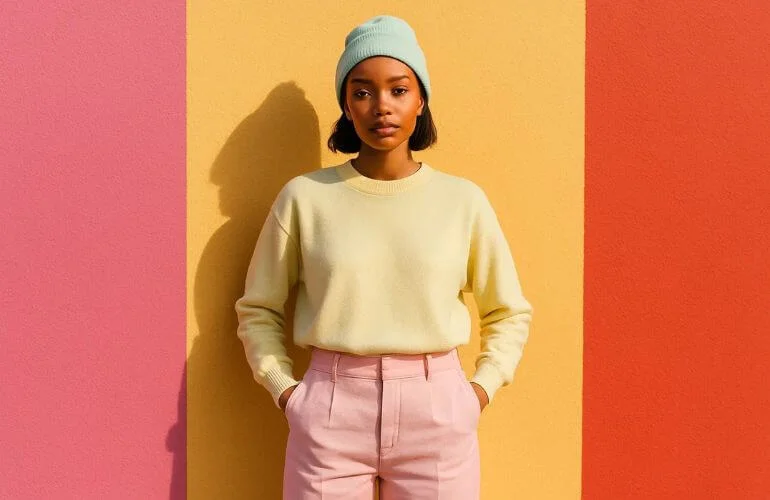Color composition plays a crucial role in pre-production photography. While professional editing services can enhance your photos later, mastering color composition during the shoot ensures better results. While expensive gear adds flexibility, true expertise comes from mastering composition and camera techniques.
What Is Color Composition?

Color composition refers to how colors are arranged in a photo or artwork. It’s about combining colors in a way that creates a visually appealing and impactful effect. To master color composition in photography, you must first understand the core principles. With hundreds of possible combinations, knowing the best ones can improve your photography significantly.
Top 10 Color Composition Techniques in Photography
Here are the top 10 color composition techniques that can enhance your photos. These fundamental combinations will help you create stunning and balanced images.
1. Use Complementary Colors

Complementary colors are one of the most effective and widely used color composition techniques in photography. The image looks eye-catching and perfect with the background color that is opposite to the subject. For example, if the subject is white, the background is best in black.
You can explore complementary color schemes using a color wheel to find impactful color combinations.
2. Enhance Sharpness with Color Contrast

The color of the subject should be sharp compared to the background. Well, that doesn’t mean the background should be dull to make the subject sharper in photography. In DSLR mode, background blur is automatic, keeping the subject sharp. Understanding how your camera functions—especially settings that affect depth of field and focus—is crucial for achieving sharp subject rendering.
3. Use Strong Subject-Background Contrast

Color composition in photography is highly dependent on the subject and background color. So, the subject color should be punchier than the background or the surroundings. While post-production editing can help, achieving the right contrast during the shoot produces more natural, high-quality results.
4. Blend Colors Harmoniously

An opposite or complementary color is a common method of highlighting the subject. But the combination of similar colors is a different technique. During photography, place the background a little farther away from the subject. Add some lighting in between and take shots from multiple angles.
5. Use Rule of Thirds with Color Awareness

The Rule of Thirds is a compositional technique that also influences how color elements are balanced within the frame. When you enter the option, the camera program will suggest to you the visual grid. You can have the scene in front divided into three horizontal or vertical forms. Also, you can use both of them together as a combination. To do better in this, use the camera grid.
6. Balance Warm and Cool Colors

Dominant and receding colors are warm and cold shades linked to complementary colors. Orange, Red, Yellow, etc. are warm colors. And, Green, Blue, Purple, etc., are cold colors. Warm colors against cool tones (or vice versa) create strong visual depth and mood. The technique makes colors fade from the subject to the background.
👉 For a deeper understanding of how these tones influence perception, read about warm vs. cool color mood differences in this comprehensive Wikipedia guide on color theory.
7. Use Bright or Bold Backgrounds

Here you can use the subject in a bright color as well, and use a shadow behind. A bright background behind the subject makes a stunning backdrop in photography. Also, we can fake it with Photoshop color composition and insert the background through photo editing.
8. Match Textures with the Subject

The implementation of textures is a trendy color composition these days. And the preparation is very simple, placing matching textured backgrounds behind. So, the photographs come out like the subject is attached to the background. This technique is especially popular in fashion photography and post-production edits.
9. Control Color Saturation In-Camera

Saturation is the depth of color in photography. When you focus on a scene, you get the natural depth through the camera. Adjust saturation in the camera settings under the Hue/Saturation panel. Different cameras may have different locations for this option. Check the settings location before starting professional photography.
10. Apply Color Harmony Principles

Photography is often a game of color harmony. Using and placing colors rhythmically can create beautiful presentations for photography. Using a contrasting color over a solid color looks stunning and eye-catching. For example, warm colors on cold colors look highlighted.
Related Article
- Adobe Color Wheel – Explore color combinations with real-time visual aids.
- Color Correction in Lightroom – Learn how to fix tones and enhance mood using Lightroom tools.
Conclusion | Color Composition in Photography
The color composition in photography has significant value for professional and personal photos. When used effectively, color composition can greatly enhance the visual impact of your photos. On the other hand, inaccurate use can ruin the whole impression and make photos useless. So, learn the techniques and shoot some photos to verify your expertise.
Need to fine-tune your color composition after the shoot? Explore our professional Color Correction Services for expert retouching and color enhancement tailored to your style.
FAQ | Color Composition in Photography
Color composition refers to how you intentionally use colors within your frame to create visual impact, guide the viewer’s eye, and evoke emotions, often using techniques like complementary colors, contrast, and harmony. It happens at the time of shooting.
Color correction, on the other hand, is a post-processing technique. It involves adjusting the colors in a photo to fix issues like white balance, exposure inconsistencies, or inaccurate hues so the image looks natural and balanced.
The best color for photography depends on the field where you are about to use the photos. Black, white, or dark colors are highly preferable for most photos. But a combination of warm and cold colors with expertise brings out the best looks.

